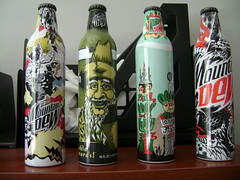The New York Times
August 10, 2007
Product Packages Now Shout to Get Your Attention
By LOUISE STORY
In the last 100 years, Pepsi had changed the look of its can, and before that its bottles, only 10 times. This year alone, the soft-drink maker will switch designs every few weeks.
Kleenex, after 40 years of sticking with square and rectangular boxes, has started selling tissues in oval packages.
Coors Light bottles now have labels that turn blue when the beer is chilled to the right temperature. And Huggies’ Henry the Hippo hand soap bottles have a light that flashes for 20 seconds to show children how long they should wash their hands.
Consumer goods companies, which once saw packages largely as containers for shipping their products, are now using them more as 3-D ads to grab shoppers’ attention.
The shift is mostly because of the rise of the Internet and hundreds of television channels, which mean marketers can no longer count on people seeing their commercials.
So they are using their bottles, cans, boxes and plastic packs to improve sales by attracting the eyes of consumers, who often make most of their shopping decisions at the last minute while standing in front of store shelves.
“The media is fragmented, and we can’t find people — we can’t get them to sit down and listen to our argument on a television spot,” said Jerry Kathman, chief executive of LPK, a brand agency based in Cincinnati. “The package can convey that argument.”
As recently as the 1990s, most package designs were retained for seven or more years. Now marketing executives say they are constantly planning package overhauls. The average life of a package before its next makeover is down to two years, they add.
Shoppers have also grown accustomed to looking for a little visual pop on aisle shelves as design has become a mainstream marketing tool — Target stores in particular use that visual pop as a key advertising theme, for example. Sameness carries a risk that a product will fade into the background.
“Consumers are looking for what’s new,” said Kimberly Drosos, director for package development at Unilever North America, which recently changed the shape of its Suave shampoo bottles for the first time in 25 years, and sells Axe shower gel bottles shaped like video-game joysticks.
Ms. Drosos added: “They say, ‘What else do you have for me? That was nice last year, but I want the packaging to be refreshing.’ ”
There are many other reasons behind the shift. Some packaging changes are occurring because companies are trying to shrink container sizes and reduce their environmental impact, or because of new approaches for old products (Orbit now sells gum in a bottle made to fit in a car’s cup holder). Some brands are bragging that their bottles of cleansers and other household products are attractive enough to be left out in plain view, rather than hidden in a closet or drawer.
“It’s an inexpensive way to really deliver that newness to people’s homes,” said Becky Walter, director for innovation design and testing at Kimberly-Clark, the maker of Kleenex, Huggies and other brands. “It’s not like they have to go out and purchase new furniture.”
Evian is among the marketers using packaging to add a sense of luxury to ordinary products — its new “palace bottle” water, for example, is being sold in restaurants and hotels. The bottle has an elegant swanlike neck and sits on a small silver tray. Technology is also driving the changes — like the thermochromatic ink in the Coors label that changes the color of the label’s mountains with the temperature of the beer bottle.
And in the next few years, Pepsi drinkers may smell a sweet aroma that is sprayed out when they pop open Pepsi cans — such as a wild cherry scent misting from a Wild Cherry Pepsi can. Executives at the company have also considered cans that can spray a light water mist when they are opened, but they are unlikely to add that feature soon because of the cost, they say.
Laurent Nielly, who heads packaging innovation for Pepsi in North America, said young people — Pepsi’s central audience — have shorter attention spans than previous generations, so bottles and other containers have to change more often. Pepsi is experimenting with the designs on its Mountain Dew bottles, selling aluminum bottles covered in graffiti-like designs that will be changed 12 times from May to October. The bottles are sold only in eastern Virginia now, but the soda maker may expand the approach if sales of the bottles go well.
If products aren’t spraying consumers, they may someday be talking to them.
Some companies are studying technology to put a computer chip and tiny speaker inside a package. This idea might be particularly useful for big companies like Unilever that want to cross-promote their various brands. So a package of cheese could say “I go well with Triscuit crackers” when a shopper takes it off the shelf. As the costs of the chips come down, marketing executives said this and other technologies would appear more on shelves.
All these packaging makeovers may make trips to the grocery stores more entertaining. Or the result could be confusion, if not downright annoyance.
“If you’re walking down a row in a supermarket and every package is screaming at you, it sounds like a terrifying, disgusting experience,” said Tracy Lovatt, director for behavioral planning at BBDO North America, an advertising agency in the Omnicom Group. “But if brands use this wisely, new packaging can be quite powerful. It’s the thing that will interrupt you at the store, and get you to spend time with that brand, and then, hopefully, buy in.”
Subscribe to:
Post Comments (Atom)


No comments:
Post a Comment